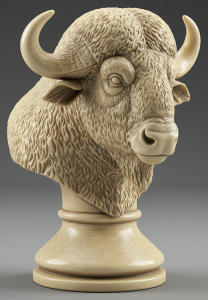Piececlopedia: Buffalo
Historical notes

The Buffalo is a piece that combines the movement possibilities of the Knight, Camel, and Zebra. It first appears as an enhanced Knight in Cavalry Chess, and under its current name in fairy problems. The first variant to use this name for it was Gigachess, and it is the strongest piece in the largest forms of Great Herd. It is called a Valiant Knight on Macrochess. The names of these variants reflect that it is a strong piece, and surprisingly suited to large boards given its short range. Indeed on the 8x8 board of Power Chaturanga it is rather too strong compared with other pieces.
Movement
The buffalo can either move two squares in one orthogonal direction and then one in the other orthogonal direction (like a Knight), or three squares in one orthogonal direction and then one in the other orthogonal direction, or three squares in one orthogonal direction and then two in the other orthogonal direction. When moving, the buffalo jumps, i.e., the move can be completed regardless of whether intervening squares are occupied. It is to the Gnu (Knight+Camel), Gazelle (Knight+Zebra), and Bison (Camel+Zebra) what the Ace or Amazon is to the Queen, Marshal, and Cardinal, that is, the three-element compound with all the combinations of the three two-element ones. Another way to view it, the way used in Power Chaturanga, is as covering all the oblique moves to its second and third perimeters - the second through the Knight move and the third through the Bison move. Perimeters are defined more fully under the Squirrel, which combines the oblique Knight with the radial Alibaba.
Movement diagram
![]()
![]()
![]()
![]()
![]()
![]()
![]()
![]()
![]()
![]()
![]()
![]()
![]()
![]()
![]()
![]()
![]()
![]()
![]()
![]()
![]()
![]()
![]()
![]()
![]()
![]()
![]()
![]()
![]()
![]()
![]()
![]()
![]()
![]()
![]()
![]()
![]()
![]()
![]()
![]()
![]()
![]()
![]()
![]()
![]()
![]()
![]()
![]()
![]()
![]()
![]()
![]()
![]()
![]()
![]()
![]()
![]()
![]()
![]()
![]()
![]()
![]()
![]()
![]()
The Buffalo can move to any square with a black circle, regardless of whether squares passed over are occupied or not.
Notes
This piece can generally force checkmate against a bare king, with the help of its friendly king. Try it!This is an item in the Piececlopedia: an overview of different (fairy) chess pieces.
Written by Charles Gilman.
WWW page created: June 23, 2005.
Last Updated: April 9, 2025.